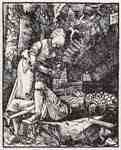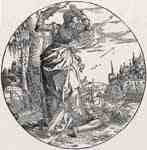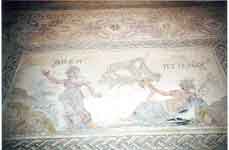.

Thisbe, by John William Waterhouse, 1909
The love story of Pyramus and Thisbe, not really a part of Roman mythology, is actually a sentimental romance. It is recounted by Hyginus (Fabulae 242) but is better told by Ovid (Metamorphoses 4).
The following is the version told by Thomas Bulfinch (The Age of Fable, 1855):
Pyramus was the handsomest youth, and Thisbe the fairest maiden, in all Babylonia, where Semiramis reigned. Their parents occupied adjoining houses; and neighborhood brought the young people together, and acquaintance ripened into love. They would gladly have married, but their parents forbade. One thing, however, they could not forbid that love should glow with equal ardor in the bosoms of both. They conversed by signs and glances, and the fire burned more intensely for being covered up. In the wall that parted the two houses there was a crack, caused by some fault in the structure. No one had remarked it before, but the lovers discovered it. 'What will love not discover? It afforded a passage to the voice; and tender messages used to pass backward and forward through the gap. As they stood, Pyramus on this side, Thisbe on that, their breaths would mingle. "Cruel wall," they said, "why do you keep two lovers apart? But we will not be ungrateful. We owe you, we confess, the privilege of transmitting loving words to willing ears." Such words they uttered on different sides of the wall; and when night came and they must say farewell, they pressed their lips upon the wall, she on her side, he on his, as they could come no nearer.
One morning, when Aurora had put out the stars, and the sun had melted the frost from the grass, they met at the accustomed spot. Then, after lamenting their hard fate, they agreed that next night, when all was still, they would slip away from watchful eyes, leave their dwellings and walk out into the fields; and to ensure a meeting, repair to a well-known edifice, standing without the city's bounds, called the tomb of Ninus, and that the one who came first should await the other at the foot of a certain tree. It was a white mulberry tree and stood near a cool spring. All was agreed on, and they waited impatiently for the sun to go down beneath the waters and night to rise up from them. Then cautiously Thisbe stole forth, unobserved by the family, her head covered with a veil, made her way to the monument and sat down under the tree. As she sat alone in the dim light of the evening she descried a lioness, her jaws reeking with recent slaughter, approaching the fountain to slake her thirst. Thisbe fled at the sight, and sought refuge in the hollow of a rock. As she fled she dropped her veil. The lioness, after drinking at the spring, turned to retreat to the woods, and seeing the veil on the ground, tossed and rent it with her bloody mouth.
Pyramus, having been delayed, now approached the place of meeting. He saw in the sand the footsteps of the lion, and the color fled from his cheeks at the sight. Presently he found the veil all rent and bloody. "Oh, hapless girl," said he, "I have been the cause of thy death! Thou, more worthy of life than I, hast fallen the first victim. I will follow. I am the guilty cause, in tempting thee forth to a place of such peril, and not being myself on the spot to guard thee. Come forth, ye lions, from the rocks, and tear this guilty body with your teeth" He took up the veil, carried it with him to the appointed tree, and covered it with kisses and with tears. "My blood also shall stain your texture," said he, and drawing his sword plunged it into his heart. The blood spurted from the wound, and tinged the white mulberries of the tree all red; and sinking into the earth reached the roots, so that the red color mounted through the trunk to the fruit.
By this time, Thisbe, still trembling with fear, yet wishing not to disappoint her lover, stepped cautiously forth, looking anxiously for the youth, eager to tell him the danger she had escaped. When she came to the spot and saw the changed color of the mulberries she doubted whether it was the same place. While she hesitated she saw the form of one struggling in the agonies of death. She started back, a shudder ran through her frame as a ripple on the face of the still water when a sudden breeze sweeps over it. But as soon as she recognized her lover, she screamed and beat her breast; embracing the lifeless body, pouring tears into its wounds, and imprinting kisses on the cold lips. "Oh, Pyramus," she cried, "what has done this? Answer me, Pyramus; it is your own Thisbe that speaks. Hear me, dearest, and lift that drooping head!" At the name of Thisbe, Pyramus opened his eyes, then closed them again. She saw her veil stained with blood and the scabbard empty of its sword. "Thy own hand has slain thee, and for my sake," she said. "I too can be brave for once, and my love is as strong as thine. I will follow thee in death, for I have been the cause; and death, which alone could part us, shall not prevent my joining thee. And ye, unhappy parents of us both, deny us not our united request. As love and death have joined us, let one tomb contain us. And thou, tree, retain the marks of slaughter. Let thy berries still serve for memorials of our blood." So saying, she plunged the sword into her breast. Her parents acceded to her wish; the gods also ratified it. The two bodies were buried in one sepulchre, and according to Ovid, Metamorphoses 4, the tree ever after brought forth purple berries, as it does to this day.
Geoffrey Chaucer was among the first to tell the story in English with his Legend of Good Women. The "Pyramus and Thisbe" plot appears twice in Shakespeare's works. The plot of Romeo and Juliet is based either on Ovid's Latin retelling in the Metamorphoses, or on Golding's 1567 translation of that work. A comic recapitulation appears in the play A Midsummer Night's Dream (Act V, sc 1), enacted by a group of "mechanicals". Edmond Rostand adapted the tale from Romeo and Juliet, making the fathers of the lovers conspire to bring their children together by pretending to forbid their love in Les Romanesques. Rostand's play, translated into English as The Fantastics was the basis for the musical of the same name. The musical West Side Story, based on Romeo and Juliet, and The Fantastics, thus have the same ultimate source.

Pyramos, Fresco from the house of D. Octavius Quartio at Pompeji

Pyramus and Thisbe, Hans Baldung

Pyramus and Thisbe, Albrecht Altdorfer

Pyramus and Thisbe, Heinrich Aldegrever
Pyramus and Thisbe, Cornelis Schut
Pyramus and Thisbe, Lucas van Leyden
See also : Greek Mythology. Paintings, Drawings
| Ancient Greece
Science, Technology , Medicine , Warfare, , Biographies , Life , Cities/Places/Maps , Arts , Literature , Philosophy ,Olympics, Mythology , History , Images Medieval Greece / Byzantine Empire Science, Technology, Arts, , Warfare , Literature, Biographies, Icons, History Modern Greece Cities, Islands, Regions, Fauna/Flora ,Biographies , History , Warfare, Science/Technology, Literature, Music , Arts , Film/Actors , Sport , Fashion --- |
Retrieved from "http://en.wikipedia.org"
All text is available under the terms of the GNU Free Documentation License




